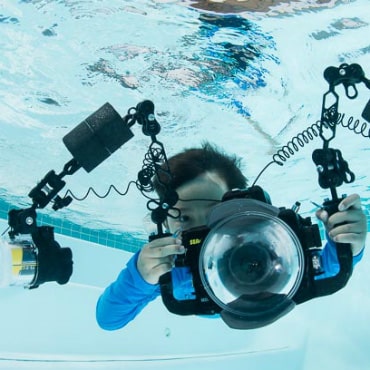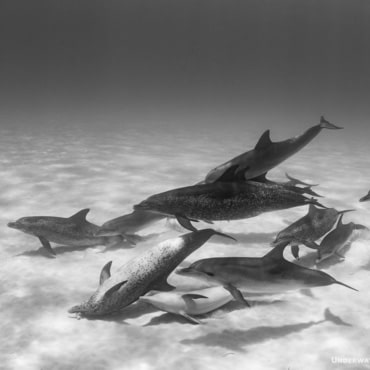Guide to Shooting with the Canon 70D
March 24th, 2014
Guide to shooting Underwater with the Canon 70D

The Canon 70D is an exciting new camera for underwater photo and video. The highlight is the Dual Pixel CMOS AF technology. In short, this new sensor provides lighting-fast autofocus for still shooters using the viewfinder as well as video shooters using autofocus in live view mode. We'll be publishing an in-depth review of the camera that explains the new technology and benefits very soon on the Underwater Photography Guide.
I shoot with a Canon 5D MkIII, primarily using the Tokina 10-17 and the Canon 100mm f/2.8L macro lenses underwater. The 70D’s autofocus is significantly faster and smoother than the 5D MkIII with the 100mm, especially in dark shooting conditions. The Tokina is also very smooth when using autofocus in video mode. If comparing to the 7D (which I owned at one point) I would choose the 70D because of the Dual-Pixel CMOS AF. It's safe to say that you’ll be seeing this technology in future Canon cameras.
Lens Selection
Tokina 10-17: Excellent fisheye lens used by most crop-sensor u/w photographers
Canon 8-15: Excellent fisheye if planning an upgrade to full frame
Canon 17-40: Great wide-angle lens for pool shoots, whales, etc. 77mm filter size.
Canon 16-35 II: Many choose this wide-angle lens over the 17-40. 82mm filter size.
Canon 10-22: Great ultra wide-angle lens for crop sensors (like the 70D)
Sigma 10-20 & Tokina 11-16: Excellent ultra wide-angle lenses that are cheaper than the 10-22. The Tokina is slightly sharper than the Sigma but also a little more expensive.
Canon 60mm macro: Excellent macro & mid-size subject lens
Canon 100mm macro: Excellent macro on small subjects
Sample Video
Canon 70D Underwater Video
- Shot entirely with autofocus, auto white balance and manual exposure
- Wide-angle shot on two dives at Catalina Island with Tokina 10-17.
- Macro shot on one dive in surgy conditions with Canon 100mm f/2.8 macro lens
Video Settings
The 70D is very “video-friendly” and performs well with most settings in Auto (autofocus, white balance, etc). It is always advisable to manually select exposure to prevent the camera from making changes in the middle of a scene. Autofocus method should be chosen based on subject using +Tracking, Flexi-Zone - Multi or Flexi-Zone - Single modes. I used all of these modes in the sample video, but note that the ideal method wasn't always used in order to push the limit of the 70D's AF capabilities (i.e. the last clip of the Lincod and eggs).
The Canon 70D offers a variety of recording sizes for underwater video. Amateurs will generally want to shoot at a recording size of 1280x720 (HD) in order to save memory space, create ease of editing and easily upload to sites like Facebook, YouTube and Vimeo. Advanced shooters will powerful computers will want to try out the 1920x1080 (Full HD) recording along with All-I compression for best editing and post production.
Housings
Ikelite 70D: Great value for price with built-in TTL for Ikelite strobes.
Sea & Sea MDX-70D: All the important video controls within easy reach with oversized buttons. Internal YS Optical Converter for stills.
Nauticam NA-70D: Great housing, engineered to place control buttons and levers at fingertips.
Aquatica A70D: Haven’t seen this yet but Aquatica is known for excellent video controls, including oversized knob for extra smooth zoom and manual focus. Extensive port/lens options.
Recsea 70D: Haven’t seen this yet, but expect it to be the smallest and lightest option.




